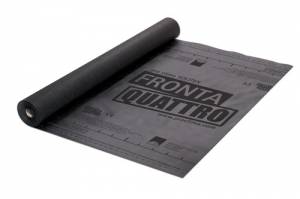Pro Clima Solitex Fronta Quattro
Available in all stores
Conditionnement
Pot en métal de 0,375 litre / 0,75 litre / 2,5 litres
Unité de vente
La pièce
SOLITEX FRONTA QUATTRO
3-ply wall lining membrane with monolithic TEEE functional membrane, suitable for open jointed and closed façadesAdvantages
- Highly diffusion-permeable, but with maximum resistance to driving rain
- Optimum drying conditions for wall structures: non-porous TEEE functional membrane actively transports moisture outwards
- Black fleece and black print prevent the membrane showing through open jointed façades
- Maximum ageing resistance and thermal stability thanks to the TEEE membrane
- 6 months of outdoor exposure
Application
SOLITEX FRONTA QUATTRO permanently protects the insulation from wind and rain. For use with closed and open façades (open jointed façades, up to 35 mm gap width – boarding width = min. 3 x gap width) in accordance with installation guidelines.
Technical specs
| Material | |
| Protective and covering fleece | Polypropylene microfibre |
| Membrane | monolithic TEEE |
| Attribute | Norm | Value |
| Colour | black, Print: black | |
| Surface weight | EN 1849-2 | 180 ±5 g/m² |
| Thickness | EN 1849-2 | 0.60 ±0.10 mm |
| Water vapour resistance factor µ | EN ISO 12572 | 80 |
| sd-value | EN ISO 12572 | 0.05 ±0.02 m |
| g-value | 0.25 ±0.1 MN·s/g | |
| Water vapor permeance | ASTM E 96 | 65.6 US perms |
| Fire behaviour | EN 13501-1 | E |
| Exposure time | 6 months | |
| Water column | EN 20811 | 10 000 mm |
| Water resistance un-/aged* | EN 1928 | W1 / W1 |
| Tensile strength MD/CD | EN 12311-1 | 290 ±20 N/5 cm / 220 ±20 N/5 cm |
| Tensile strength MD/CD aged* | EN 12311-1 | 200 ±20 N/5 cm / 135 ±20 N/5 cm |
| Elongation MD/CD | EN 12311-1 | 50 ±20 % / 70 ±20 % |
| Elongation MD/CD aged* | EN 12311-1 | 30 ±20 % / 40 ±20 % |
| Nail tear resistance MD/CD | EN 12310-1 | 250 ±30 N / 240 ±30 N |
| *) Artificial ageing by long term | EN 1297 / EN 1296 | passed (for walls with open joints) |
| Flexibility at low temperature | EN 1109 | -40 °C/-40 °F |
| Temperature resistance | -40 °C/-40 °F to +100 °C/212 °F | |
| Coefficient of thermal conductivity | 0.17 W/m·K | |
| CE labelling | EN 13859-2 | available |
Limiting factors
SOLITEX FRONTA QUATTRO membranes must be laid with the printed side facing outwards. They can be laid flat either at right angles to, or along the sub-structure without sagging. Horizontal installation is preferable with regard to water tightness during the construction phase.
When using behind open jointed façades the gaps must not be more than 35 mm. The width of the boarding: min. 3 x gap width.
The distance between the façade and the membrane must be at least 20 mm.
The membrane must not be secured in areas where water collectively drains off.
Additional measures during the building phase (e.g. covering with tarpaulin) should be taken in the case of occupied buildings or buildings that need particular protection. Covering with tarpaulin should also be considered in the case of extended interruptions to work.
